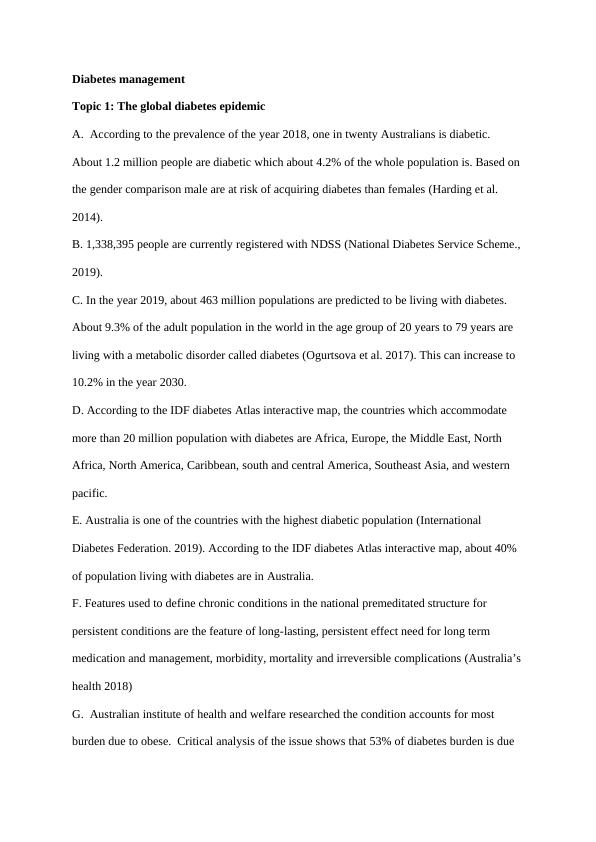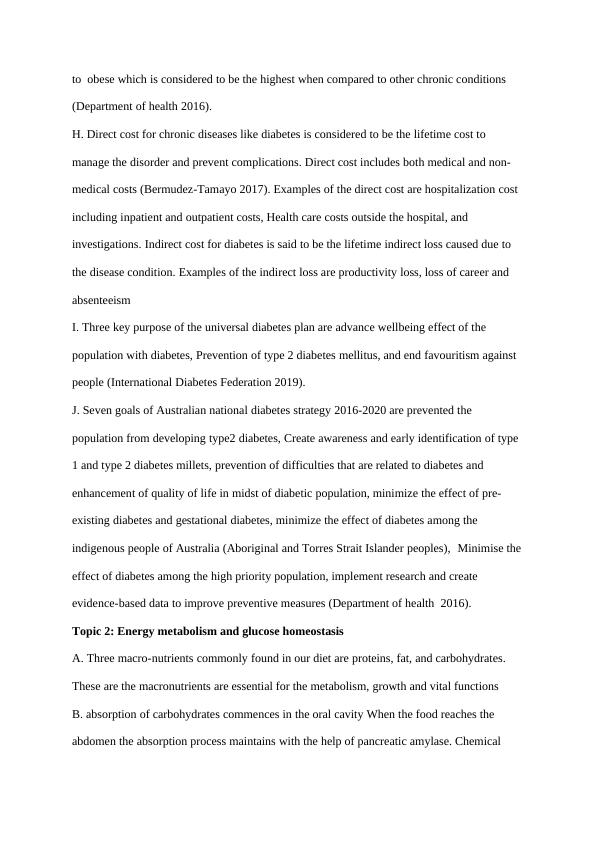Diabetes Management Assessment
9 Pages2532 Words13 Views
Added on 2022-08-23
About This Document
.
Diabetes Management Assessment
Added on 2022-08-23
ShareRelated Documents
Diabetes management
Topic 1: The global diabetes epidemic
A. According to the prevalence of the year 2018, one in twenty Australians is diabetic.
About 1.2 million people are diabetic which about 4.2% of the whole population is. Based on
the gender comparison male are at risk of acquiring diabetes than females (Harding et al.
2014).
B. 1,338,395 people are currently registered with NDSS (National Diabetes Service Scheme.,
2019).
C. In the year 2019, about 463 million populations are predicted to be living with diabetes.
About 9.3% of the adult population in the world in the age group of 20 years to 79 years are
living with a metabolic disorder called diabetes (Ogurtsova et al. 2017). This can increase to
10.2% in the year 2030.
D. According to the IDF diabetes Atlas interactive map, the countries which accommodate
more than 20 million population with diabetes are Africa, Europe, the Middle East, North
Africa, North America, Caribbean, south and central America, Southeast Asia, and western
pacific.
E. Australia is one of the countries with the highest diabetic population (International
Diabetes Federation. 2019). According to the IDF diabetes Atlas interactive map, about 40%
of population living with diabetes are in Australia.
F. Features used to define chronic conditions in the national premeditated structure for
persistent conditions are the feature of long-lasting, persistent effect need for long term
medication and management, morbidity, mortality and irreversible complications (Australia’s
health 2018)
G. Australian institute of health and welfare researched the condition accounts for most
burden due to obese. Critical analysis of the issue shows that 53% of diabetes burden is due
Topic 1: The global diabetes epidemic
A. According to the prevalence of the year 2018, one in twenty Australians is diabetic.
About 1.2 million people are diabetic which about 4.2% of the whole population is. Based on
the gender comparison male are at risk of acquiring diabetes than females (Harding et al.
2014).
B. 1,338,395 people are currently registered with NDSS (National Diabetes Service Scheme.,
2019).
C. In the year 2019, about 463 million populations are predicted to be living with diabetes.
About 9.3% of the adult population in the world in the age group of 20 years to 79 years are
living with a metabolic disorder called diabetes (Ogurtsova et al. 2017). This can increase to
10.2% in the year 2030.
D. According to the IDF diabetes Atlas interactive map, the countries which accommodate
more than 20 million population with diabetes are Africa, Europe, the Middle East, North
Africa, North America, Caribbean, south and central America, Southeast Asia, and western
pacific.
E. Australia is one of the countries with the highest diabetic population (International
Diabetes Federation. 2019). According to the IDF diabetes Atlas interactive map, about 40%
of population living with diabetes are in Australia.
F. Features used to define chronic conditions in the national premeditated structure for
persistent conditions are the feature of long-lasting, persistent effect need for long term
medication and management, morbidity, mortality and irreversible complications (Australia’s
health 2018)
G. Australian institute of health and welfare researched the condition accounts for most
burden due to obese. Critical analysis of the issue shows that 53% of diabetes burden is due

to obese which is considered to be the highest when compared to other chronic conditions
(Department of health 2016).
H. Direct cost for chronic diseases like diabetes is considered to be the lifetime cost to
manage the disorder and prevent complications. Direct cost includes both medical and non-
medical costs (Bermudez-Tamayo 2017). Examples of the direct cost are hospitalization cost
including inpatient and outpatient costs, Health care costs outside the hospital, and
investigations. Indirect cost for diabetes is said to be the lifetime indirect loss caused due to
the disease condition. Examples of the indirect loss are productivity loss, loss of career and
absenteeism
I. Three key purpose of the universal diabetes plan are advance wellbeing effect of the
population with diabetes, Prevention of type 2 diabetes mellitus, and end favouritism against
people (International Diabetes Federation 2019).
J. Seven goals of Australian national diabetes strategy 2016-2020 are prevented the
population from developing type2 diabetes, Create awareness and early identification of type
1 and type 2 diabetes millets, prevention of difficulties that are related to diabetes and
enhancement of quality of life in midst of diabetic population, minimize the effect of pre-
existing diabetes and gestational diabetes, minimize the effect of diabetes among the
indigenous people of Australia (Aboriginal and Torres Strait Islander peoples), Minimise the
effect of diabetes among the high priority population, implement research and create
evidence-based data to improve preventive measures (Department of health 2016).
Topic 2: Energy metabolism and glucose homeostasis
A. Three macro-nutrients commonly found in our diet are proteins, fat, and carbohydrates.
These are the macronutrients are essential for the metabolism, growth and vital functions
B. absorption of carbohydrates commences in the oral cavity When the food reaches the
abdomen the absorption process maintains with the help of pancreatic amylase. Chemical
(Department of health 2016).
H. Direct cost for chronic diseases like diabetes is considered to be the lifetime cost to
manage the disorder and prevent complications. Direct cost includes both medical and non-
medical costs (Bermudez-Tamayo 2017). Examples of the direct cost are hospitalization cost
including inpatient and outpatient costs, Health care costs outside the hospital, and
investigations. Indirect cost for diabetes is said to be the lifetime indirect loss caused due to
the disease condition. Examples of the indirect loss are productivity loss, loss of career and
absenteeism
I. Three key purpose of the universal diabetes plan are advance wellbeing effect of the
population with diabetes, Prevention of type 2 diabetes mellitus, and end favouritism against
people (International Diabetes Federation 2019).
J. Seven goals of Australian national diabetes strategy 2016-2020 are prevented the
population from developing type2 diabetes, Create awareness and early identification of type
1 and type 2 diabetes millets, prevention of difficulties that are related to diabetes and
enhancement of quality of life in midst of diabetic population, minimize the effect of pre-
existing diabetes and gestational diabetes, minimize the effect of diabetes among the
indigenous people of Australia (Aboriginal and Torres Strait Islander peoples), Minimise the
effect of diabetes among the high priority population, implement research and create
evidence-based data to improve preventive measures (Department of health 2016).
Topic 2: Energy metabolism and glucose homeostasis
A. Three macro-nutrients commonly found in our diet are proteins, fat, and carbohydrates.
These are the macronutrients are essential for the metabolism, growth and vital functions
B. absorption of carbohydrates commences in the oral cavity When the food reaches the
abdomen the absorption process maintains with the help of pancreatic amylase. Chemical

digestion of carbohydrates happens in the stomach. Most of the digestion and absorption
process occurs in the small intestine. Pancreatic amylase is the only enzyme that supports
digestion in the stomach and small intestine. The inner lining of the small intestine plays a
vital role in the absorption of carbohydrates (Goodman 2010). Carbohydrates that are not
digested in the small intestine are passed to the large intestine. No process of digestion or
absorption happens in the large intestine. Bacteria living in the large intestine take the
undigested carbohydrate as feed.
C. The glucose is term as glycogen when stored. Absorbed carbohydrate is processed by the
liver and allowed to circulate with the blood. The glycogen is converted into glucose
whenever needed (Ramnanan et al. 2011).
D. Most of the vital organs use glucose for energy. Brain the only organ that uses a major part
of the glucose for energy. The nervous system including neurons uses glucose for energy.
Other organs that use glucose for energy are muscles, adipose tissue, and kidney.
E. Glycogenolysis is the term used for the process of breakdown of glycogen into glucose.
Glucose is the simple and broken form of sugar that is used for energy production. The
Glycogenolysis process takes place in muscles and liver when the sudden need for glucose.
Glycogenosis is the reverse process of Glycogenolysis (Hatting et al. 2018). It is the
formation of glycogen from the glucose molecules. Glycogenosis is also termed as glycogen
storage disease.
F. The structure of proinsulin is made of 81 residues which are structured by three different
chains. Proinsulin is the protein molecule that considered an ancestor hormone. Insulin is the
hormone produced by the beta cells of the pancreatic cells (Jörnvall et al. 2010).
G. Low plasma C-peptide indicates that the body is not making needed insulin which is
considered to be the sign of diabetes or disorder of the adrenal glands (Jörnvall et al. 2010).
process occurs in the small intestine. Pancreatic amylase is the only enzyme that supports
digestion in the stomach and small intestine. The inner lining of the small intestine plays a
vital role in the absorption of carbohydrates (Goodman 2010). Carbohydrates that are not
digested in the small intestine are passed to the large intestine. No process of digestion or
absorption happens in the large intestine. Bacteria living in the large intestine take the
undigested carbohydrate as feed.
C. The glucose is term as glycogen when stored. Absorbed carbohydrate is processed by the
liver and allowed to circulate with the blood. The glycogen is converted into glucose
whenever needed (Ramnanan et al. 2011).
D. Most of the vital organs use glucose for energy. Brain the only organ that uses a major part
of the glucose for energy. The nervous system including neurons uses glucose for energy.
Other organs that use glucose for energy are muscles, adipose tissue, and kidney.
E. Glycogenolysis is the term used for the process of breakdown of glycogen into glucose.
Glucose is the simple and broken form of sugar that is used for energy production. The
Glycogenolysis process takes place in muscles and liver when the sudden need for glucose.
Glycogenosis is the reverse process of Glycogenolysis (Hatting et al. 2018). It is the
formation of glycogen from the glucose molecules. Glycogenosis is also termed as glycogen
storage disease.
F. The structure of proinsulin is made of 81 residues which are structured by three different
chains. Proinsulin is the protein molecule that considered an ancestor hormone. Insulin is the
hormone produced by the beta cells of the pancreatic cells (Jörnvall et al. 2010).
G. Low plasma C-peptide indicates that the body is not making needed insulin which is
considered to be the sign of diabetes or disorder of the adrenal glands (Jörnvall et al. 2010).

End of preview
Want to access all the pages? Upload your documents or become a member.
Related Documents
Diabetes Prevention and Control: Health Promotion Intervention Objectives for Australialg...
|8
|2018
|255
Physical inactivity as a risk factor of chronic disease burden in Australialg...
|9
|2224
|136
Lifetime Risk of Diabetes and Obesity in Metropolitan Adelaidelg...
|9
|2306
|67
The National Health Priority Areas (NHPA)lg...
|9
|2380
|29
Childhood Obesity and its Impact on Health and Societylg...
|9
|1838
|21
Challenges Faced by People with Diabetes in Accessing Information and Medical Carelg...
|13
|3140
|344
